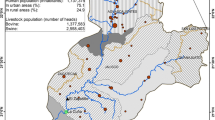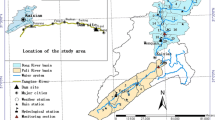Abstract
The quantification of point and non-point losses of Nitrogen (N) and Phosphorus (P) to surface waters is currently a major issue for the implementation of Environmental Directives, such as the Water Framework Directive in Europe. However, the drivers behind nutrient pollution are location specific and are affected by regional hydroclimatic and geomorphological characteristics. In this study the river basin model SWAT was used in order to improve the process-based understanding of mechanisms behind nutrient transport from land to water recipients in two European catchments with significantly different meteorological conditions: the Greek catchment of Ali Efenti, representative of the Mediterranean climate, and the Norwegian catchment of Vansjø-Hobølv, representative of the cold climate typical in Scandinavia. The models were firstly calibrated according to measured river flows and nutrient loads, and then four Best Management Practices (BMPs), related to nutrient application and soil management were applied in order to examine their effectiveness under the different geoclimatic conditions of the two catchments. The results of the baseline indicated that diffuse agricultural sources were the largest contributor of N losses in both catchments and of P losses in the Greek catchment, while point sources were significant contributors to P levels in Norwegian rivers. Nutrient losses to surface waters in Ali Efenti exhibited high seasonal variation, attributed to the extremeness of precipitation events that is typical in the Mediterranean, as well as to the temporal distribution of sediment losses to waters. On the other hand, in Scandinavia, the losses of N and P occurred with less deviation throughout the year and independently of the freezing of soils. The values of the calibrated parameters that mainly governed the hydrological and erosion processes in the catchments demonstrated the natural driving forces of nutrient losses to waters and their temporal distribution indicating that these forces are also crucial in determining the appropriate implementation of agricultural management practices in various geoclimatic regions.





Similar content being viewed by others
References
Anatolaki C, Tsitouridou R (2007) Atmospheric deposition of nitrogen, sulfur and chloride in Thessaloniki, Greece. Atmos Res 85(3–4):413–428
Arabi M, Govindaraju RS, Hantush MM, Engel BA (2006) Role of watershed subdivision on modeling the effectiveness of best management practices with swat. J Am Water Resour Assoc 42(2):513–528
Arabi M, Frankenberger JR, Engel BA, Arnold JG (2008) Representation of agricultural conservation practices with SWAT. Hydrol Process 22(16):3042–3055
Arnold JG, Srinivasan R, Muttiah RS, Williams JR (1998) Large area hydrologic modeling and assessment part I: model development. J Am Water Resour Assoc 34(1):73–89
Barlund I, Kirkkala T, Malve O, Kamari J (2007) Assessing SWAT model performance in the evaluation of management actions for the implementation of the Water Framework Directive in a Finnish catchment. Environ Model Softw 22(5):719–724
Behera S, Panda R (2006) Evaluation of management alternatives for an agricultural watershed in a sub-humid subtropical region using a physical process based model. Agric Ecosyst Environ 113:62–72
Bracmort KS, Arabi M, Frankenberger JR, Engel BA, Arnold JG (2006) Modeling long-term water quality impact of structural BMPs. Trans ASABE 49(2):367–374
Cherry KA, Shepherd M, Withers PJA, Mooney SJ (2008) Assessing the effectiveness of actions to mitigate nutrient loss from agriculture: a review of methods. Sci Total Environ 406(1–2):1–23
COST Action 869 2005. Mitigation Options for nutrient reduction in surface water and groundwaters. http://www.cost869.alterra.nl/Fs/List_of_options.htm. Accessed April 2010.
Council Directive 91/271/EEC of 21 May 1991 concerning Urban Waste Water Treatment (91/271/EEC). Official Journal of the European Communities L135.
Council Directive 91/676/EEC of 12 December 1991 concerning the protection of waters against pollution caused by nitrates from agricultural sources. Official Journal of the European Communities L375.
Deelstra J, Kværnø SH, Granlund K, Sileika AS, Gaigalis K, Kyllmar K, Vagstad N (2009) Runoff and nutrient losses during winter periods in cold climates-requirements to nutrient simulation models. J Environ Monit 11:602–609
Directive 2000/60/EC of the European Parliament and of the council of 23 October 2000 establishing a framework for Community action in the field of water policy. Official Journal of the European Communities L327/1.
Directive 2000/60/EC - Article 5 2006. Report on the pressures and qualitative characteristics of water bodies in the water districts of Greece and a methodological approach for further analysis. Hellenic republic ministry of environment physical planning and public works. http://circa.europa.eu/Public/irc/env/wfd/library?l=/framework_directive/implementation_documents_1/wfd_reports/member_states/greece/article_5/article_130606pdf/_EN_1.0_&a=d. Accessed June 2010.
Di Luzio M, Srinivasan R, Arnold JG (2001) Arcview interface for SWAT 2000. Blackland Research Center, Texas
Di Luzio M, Srinivasan R, Arnold JG (2004) A GIS-coupled hydrological model system for the watershed assessment of agricultural nonpoint and point sources of pollution. Trans in GIS 8(1):113–136
EEA-ETC/TE (2002). CORINE Land Cover update. I&CLC 2000 project, Technical Guidelines, http://etc-lusi.eionet.europa.eu/.
EEA (2005) Source Apportionment of nitrogen and phosphorus inputs into the aquatic environment. EEA Report No. 7/2005. European Environmental Agency, Copenhagen, 48 pp.
EUROHARP (2001). Towards European Harmonised Procedures for Quantification of Nutrient Losses from Diffuse Sources. An EC Framework V project number EVK-CT-2001-00096, www.euroharp.org. Accessed March 2010.
Eurostat, 2000. http://epp.eurostat.ec.europa.eu. Accessed in April 2010.
Gassman PW, Osei E, Saleh A, Rodecap J, Norvell S, Williams J (2006) Alternative practices for sediment and nutrient loss control on livestock farms in northeast Iowa. Agric Ecosyst Environ 117(2–3):135–144
Gassman PW, Reyes MR, Green CH, Arnold JG (2007) The soil and water assessment tool: historical development, applications, and future research directions. Trans ASABE 50(4):1211–1250
Johnsson H, Lunding LC (1991) Surface runoff and soil water percolation as affected by snow and soil frost. J Hydrol 122:141–159
Kronvang B, Behrendt H, Andersen HE, Arheimer B, Barr A, Borgvang SA, Bouraoui F, Granlund K, Grizzetti B, Groenendijk P, Schwaiger E, Hejzlar J, Hoffmann L, Johnsson H, Panagopoulos Y, Lo Porto A, Reisser H, Schoumans O, Anthony S, Silgram M, Venohr M, Larsen SE (2009) Ensemble modelling of nutrient loads and nutrient load partitioning in 17 European catchments. J Environ Monit 11:572–583
Lam QD, Schmalz B, Fohrer N (2010) Modelling point and diffuse source pollution of nitrate in a rural lowland catchment using the SWAT model. Agric Water Manage 97(2):317–325
Lenhart T, Eckhardt K, Fohrer N, Frede H-G (2002) Comparison of two different approaches of sensitivity analysis. Phys Chem Earth 27(9–10):645–654
Moriasi DN, Arnold JG, Liew MW, Bingner RL, Harmel RD, Veith TL (2007) Model evaluation guidelines for systematic quantification of accuracy in watershed simulations. Trans ASABE 50(3):885–900
Nash JE, Sutcliffe V (1970) River flow forecasting through conceptual models. I. A discussion of principles. J Hydrol 10:282–290
Neitsch SL, Arnold JG, Kiniry JR, Williams JR (2001) Soil and water assessment tool–theoretical documentation-version 2000. Blackland Research Center – Agricultural Research Service, Texas, USA. http://swatmodel.tamu.edu/media/1290/swat2000theory.pdf.
Neitsch SL, Arnold JG, Kiniry JR, Williams JR (2005a) Soil and water assessment tool–theoretical documentation-version 2005. Blackland Research Center – Agricultural Research Service, Texas USA. http://swatmodel.tamu.edu/media/1292/SWAT2005theory.pdf.
Neitsch SL, Arnold JG, Kiniry JR, Srinivasan R, Williams JR (2005b) Soil and Water assessment tool - input/Output file documentation-version 2005. Blackland Research Center – Agricultural Research Service, Texas – USA. http://swatmodel.tamu.edu/media/1291/SWAT2005io.pdf.
Panagopoulos I, Mimikou M, Kapetanaki M (2007a) Estimation of nitrogen and phosphorus losses to surface water and groundwater through the implementation of the SWAT model for Norwegian soils. J Soils Sediments 7(4):223–231
Panagopoulos Y, Polyzoi E, Mimikou M (2007b) Land use change effects on river sediment yields in Western Greece. Published in 4th International SWAT Conference Proceedings, 2/7-6/7/2007, Delft, The Netherlands.
Panagopoulos Y, Georgiou E, Grammatikogiannis A, Polizoi E, Mimikou M (2008) Impacts of human interaction on the sediment transport processes in the Arachtos River Basin, Western Greece. European Water 21(22):3–16
Safiolea R, Makropoulos C, Mimikou M (2009) Benefits and challenges in integrated water resources modeling using OpenMI: The case of the Pinios river basin, Greece. CCWI Conference, Sheffield, September 2009
Sahu M, Gu RR (2009) Modeling the effects of riparian buffer zone and contour strips on stream water quality. Ecol Eng 35:1167–1177
Santhi C, Srinivasan R, Arnold JG, Williams JR (2006) A modeling approach to evaluate the impacts of water quality management plans implemented in a watershed in Texas. Environ Model Softw 21:1141–1157
Schoumans OF, Chardon WJ (2003) Risk assessment methodologies for predicting phosphorus losses. J Plant Nutr Soil Sci 166(4):403–408
Schoumans OF, Silgram M, Groenendijk P, Bouraoui F, Andersen HE, Kronvang B, Behrendt H, Arheimer B, Johnsson H, Panagopoulos Y, Mimikou M, Lo Porto A, Reisser H, Le Gall G, Barr A, Anthony SG (2009a) Description of nine nutrient loss models: capabilities and suitability based on their characteristics. J Environ Monit 11:506–514
Schoumans OF, Silgram MD, Walvoort JJ, Groenendijk P, Bouraoui F, Andersen HE, Lo Porto A, Reisser H, Le Gall G, Anthony SG, Arheimer B, Johnsson H, Panagopoulos Y, Mimikou M, Zweynert U, Behrendt H, Barr A (2009b) Evaluation of the difference of eight model applications to assess diffuse annual nutrient losses from agricultural land. J Environ Monit 11:540–553
Schoumans OF, Chardon WJ, Bechmann M, Gascuel-Odoux C, Hofman G, Kronvang B, Litaor MI, Lo Porto A, Newell-Price P, Rubæk G (2011) Mitigation options for reducing nutrient emissions from agriculture. A study amongst European member states of Cost action 869. Wageningen, Alterra-Report 2141. 144 p. http://www.cost869.alterra.nl/Report2141.pdf.
Stalnacke P, Pengerud A, Bechmann M, Garnier J, Humborg C, Novotny V (2009) Nitrogen driving force and pressure relationships at contrasting scales: Implications for catchment management. Int J River Basin Manage 7(3):221–232
Tuppad P, Kannan N, Srinivasan R, Rossi CG, Arnold JG (2010) Simulation of agricultural management alternatives for watershed protection. Water Resour Manage 24(12):3115–3144
Tzoraki O, Nikolaidis NP (2007) A generalized framework for modeling the hydrologic and biogeochemical response of a Mediterranean temporary river basin. J Hydrol 346:112–121
Ullrich A, Volk M (2009) Application of the Soil and Water Assessment Tool (SWAT) to predict the impact of alternative management practices on water quality and quantity. Agric Water Manage 96(8):1207–1217
USDA, Soil Conservation Service 1972. Section 4: Hydrology in National Engineering Handbook. SCS.
Van Griensven A, Meixner T, Grunwald S, Bishop T, Diluzio M, Srinivasan R (2006) A global sensitivity analysis tool for the parameters of multi-variable catchment models. J Hydrol 324(1–4):10–23
Varanou E, Gkouvatsou E, Baltas E, Mimikou M (2002) Quantity and quality integrated catchment modelling under climatic change with use of soil and water assessment tool model. J Hydrol Eng 7(3):228–244
Zarris D, Lykoudi E, Koutsoyiannis D (2001) Final Report, Appraisal of river sediment deposits in reservoirs of hydropower dams, Contractor: Department of Water Resources, Hydraulic and Maritime Engineering – National Technical University of Athens, 243 pages, October 2001.
Acknowledgments
The current study has been partly conducted within the EC funded project EUROHARP, EC Framework V (EVK-2001-00062, www.euroharp.org). Norwegian data were provided by the Center for Soil and Environmental Research, JORDFORSK, Ås Norway, while Greek data were provided by the Laboratory of Hydrology and Water Resources Management of NTUA with the cooperation of the Public Power Corporation, the Hellenic Ministry for the Environment, Physical Planning & Public Works and the National Institution of Geology and Mineral Exploration. All data are held within the JRC-EC under the Catchment Information System (CIS) project.
Author information
Authors and Affiliations
Corresponding author
Rights and permissions
About this article
Cite this article
Panagopoulos, Y., Makropoulos, C. & Mimikou, M. Diffuse Surface Water Pollution: Driving Factors for Different Geoclimatic Regions. Water Resour Manage 25, 3635–3660 (2011). https://doi.org/10.1007/s11269-011-9874-2
Received:
Accepted:
Published:
Issue Date:
DOI: https://doi.org/10.1007/s11269-011-9874-2




